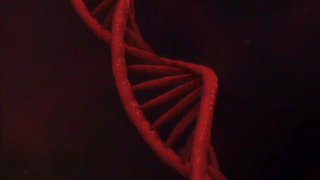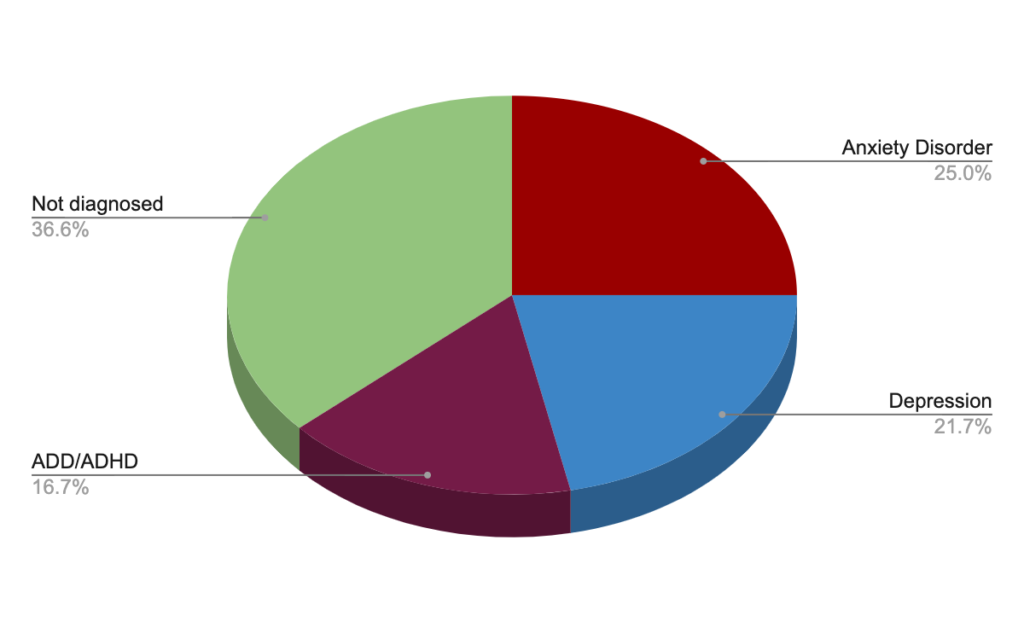“Chitalianese!” My relatives exclaimed this term, attempting to come up with a word that could encapsulate my multifaceted identity as a Chinese female adopted by white, Euro-American parents.
While their intentions were not malicious, internally, I was jarred. The different remnants of my Asian parents embedded in my DNA and my Italian-American upbringing tug at me, provoking questions that elucidate a plurality of contradictory identities.
Chinese folklore says, “When a child is born, invisible red threads reach out from a child’s spirit and connect it to all important people who will enter the child’s life. As the child grows, the threads shorten, bringing closer those people who are destined to be together.”
cohen 2015

Figure 1. 3D animated gif of a red DNA helix to symbolize the red thread narrative and a plurality of identities associated with Chinese adoptees. Chinese folklore states that an invisible red thread connects adoptees to their adoptive families, meaning that they are meant to be together (Cohen 2015). Red in the animation is also in reference to blood: the biological component of an adoptee’s identity. As the animation slows down, the red helix shows words associated with the bargaining of multiple identities. The words/phrases are the connectors in the DNA helix. The presence of these emotionally charged words indicate that an adoptee’s identity cannot be simplified to the biological components of their DNA, rather, this animation highlights the duality of biological and emotional connectors embedded in an adoptee’s sense of self.
HISTORY OF CHINESE ADOPTEES IN THE UNITED STATES
The internalized tensions between my different identities are not unique to my experience. With the implementation of China’s one-child policy between 1979 and 2016, the number of adopted children from China into the United States skyrocketed. Ninety-five percent of Chinese adoptees were female (Johnson, Banghan, and Liyao 1998). As a result, Chinese adoptees are placed in a vulnerable position as they invisibly negotiate and reconstruct multiple binaries such as:
- Internal View of Self vs. External Appearance
- Ethnically Chinese vs. Culturally American
- Exclusion vs. Belonging
These dualities raise awareness of the notion that “identity is not a stable configuration of psychological patterns, but a dynamic and adaptive process of constant trade-offs between plural identities that converge into a single selfhood” (Blair and Liu 2020).
Internal View of Self vs. External Appearance
McGinnis, Smith, Ryan Et al. 2009“I can’t count the number of days/times that I would wish and pray and beg to wake up with blonde hair and blue eyes. . . . I was the diversity in my high school. I denied my ethnicity and did everything in my power to assimilate, to emulate how White and non-Asian I was.”
Adoptees both receive and pose questions regarding the disruption between their internal view of self and their external appearance. Contrary to individuals who maintain a cohesive self whose internal view matches with their external appearance, adoptees experience internal strife on a day-to-day basis. It is in these moments of introspective tension that highlight the demands of presenting a unified identity within society (Goffman 1956).
As Asians, Chinese adoptees are associated with a marginalized group of people whose external appearance is tied to a long history of discrimination and microagressions from other Americans (Kiang and Witkow 2018). Regardless of Chinese adoptees’ internalized perceptions of themselves as American, their DNA is a perpetual marker of their foreignness.
Thus, there is a clashing of identities that some adoptees describe as being “a white person in a Chinese person’s body” (Blair and Liu 2020).
Ethnically Chinese vs. Culturally American
“I’m Asian, but I’m the whitest Asian ever.”
Blair and Liu 2020
Competing layers of being ethnically Chinese and culturally American add another dimension of complexity to adoptees’ identities. Depending on the parents’ decision to help connect their children to their ethnic Chinese culture, adoptees lack exposure and/or depth of immersion in their ethnic cultural norms and customs. This lack of bicultural integration causes some Chinese adoptees to feel guilty, distanced, or even separated altogether from their ethnicity (Reynolds, Elimelech, Miller et al. 2021).
Simultaneously, Chinese-adoptees attempt to assimilate to American culture and express strong identification with this dominant in-group. In doing so, Chinese-adoptees employ a variety of techniques such as “overcompensating,” “manipulating stereotypes,” and “bargaining.” It is not uncommon for Chinese-adoptees to be designated as “whitewashed” or praised for being good at math because of their ethnicity (Sue, Alsaidi, Awad et al. 2019). Their feelings of disconnection to their ethnicity coupled with their vulnerability in American culture is another mental battle that adoptees forcibly endure and painfully reconstruct.
Exclusion vs. Belonging
“I still feel really distant to Chinese culture. I feel like I don’t really belong and I guess I’m kind of scared to get involved in it because I don’t think I’m going to be accepted.”
Blair and Liu 2018
With the tensions of the aforementioned binaries, it is unsurprising that Chinese adoptees experience dual exclusion and belonging in relation to their birth culture and adoptive culture. Due to their upbringing in a different culture, Chinese-adoptees may feel hesitant or detached from their ethnic culture.
At the same time, Chinese adoptees receive conscious and subconscious signals that they are not included in the American in-group. Whether it is the derisive slanting of eyes from elementary school peers or the punchline of a racist, outdated joke, these stinging interactions accumulate. Feelings of shame result from exclusion from both cultures as adoptees strive for unconditional belonging (Tessler and Gamache 2010).
Why this matters: The Toll of Identity Tensions
With an unstable sense of identity at the core of an adoptee’s being, the conceptualization of these competing facets can have deleterious emotional effects (Tan, Hao, Wang et al. 2021).

The importance of a cohesive identity
Developmental psychopathologist, Erik Erikson, maintains that “Coming to terms with one’s identity is a developmental process” (Erikson 1968). As adoptees reconcile these competing binaries of internal view of self vs. external appearance, ethnically Chinese vs. culturally American, and exclusion vs. belonging, they can come to terms with the plurality, ambivalence, and dissonance between all of their identities. By deconstructing each facet, adoptees essentially unravel the aspects of disunity within their identity.
Chinese adoptees must undergo deliberate, concentrated efforts to accept the wholeness that comes with cultural pluralism which requires healing on a deep, introspective level. Instead of battling between their identities, Chinese adoptees deconstruct and reconstruct this plurality.
The unraveling of the DNA strand in the art piece represents this quintessential cognitive shift which begins with a simple acknowledgment: Something so basic as DNA itself has embedded complexities masked by a convoluted ethnic front.
References
Blair, Maya, and Meina Liu. 2020. “Ethnically Chinese and culturally American: Exploring bicultural identity negotiation and co-cultural communication of Chinese-American female adoptees.” Journal of International and Intercultural Communication 13(4). Retrieved October 2, 2022 (https://doi.org/10.1080/17513057.2019.1649710).
Cohen, Frayda. 2015. “Tracing the Red Thread: Chinese-U.S. Transnational Adoption and the Legacies of ‘Home.'” Anthropologica 57(1). Retrieved October 10, 2022 (https://www.proquest.com/scholarly-journals/tracing-red-thread-chinese-u-s-transnational/docview/1690736211/se-2).
Erikson, Erik. 1968. Identity: Youth and Crisis. Oxford, England: Norton & Co. Retrieved October 17, 2022 (https://www.academia.edu/37327712/Erik_H_Erikson_Identity_Youth_and_Crisis_1_1968_W_W_Norton_and_Company_1_).
Goffman, Erving. 1956. The Presentation of Self in Everyday Life. Scotland: University of Edinburgh, Social Sciences Research Centre. Retrieved October 17, 2022 (https://monoskop.org/images/1/19/Goffman_Erving_The_Presentation_of_Self_in_Everyday_Life.pdf).
Johnson, Kay, Huang Banghan, and Wang Liyao. 1998. “Infant Abandonment and Adoption in China.” Population and Development Review 24(3). Retrieved November 10, 2022 (https://doi.org/10.2307/2808152).
Kiang, Lisa, and Melissa R. Witkow. 2018. “Identifying as American among Adolescents from Asian Backgrounds.” Journal of Youth Adolescence 47. Retrieved October 4, 2022. (https://doi.org/10.1007/s10964-017-0776-3).
Kim, Tae-Sun. 2009. “Alien Asian: The Role of Racial Exclusion and Cultural Differentiation in the Identity Development of Transnationally Adopted Korean Americans.” Ph.D. Dissertation, Anthropology, University of Michigan State. ProQuest Dissertations, AAI3396100. Retrieved October 1, 2022 (https://www.proquest.com/dissertations-theses/alien-asian-role-racial-exclusion-cultural/docview/818805441/se-2).
McGinnis, Hollee, Susan L. Smith, Scott D. Ryan, and Jeanne A. Howard. 2009. Beyond Culture Camp: Promoting Healthy Identity Formation in Adoption. New York: Evan B. Donaldson Adoption Institute. Retrieved November 13, 2022 (https://affcny.org/wp-content/uploads/2009_11_BeyondCultureCamp.pdf).
Reynolds, Jason D., Nicole T. Elimelech, Simonleigh P. Miller, Megan E. Ingraham, Bridget M. Anton, and Chiroshri Bhattacharjee. 2020. “In Their Own Voices: Identity and Racial Socialization Experiences of Young Adult Chinese Adoptees.” Review of General Psychology 25(1). Retrieved November 9, 2022 (https://doi.org/10.1177/1089268020963597).
Sue, Derald W., Sarah Alsaidi, Michael N. Awad, Elizabeth Glaeser, Cassandra Z. Calle, and Narolyn Mendez. 2019. “Disarming Racial Microaggressions: Microintervention Strategies for Targets, White Allies, and Bystanders.” American Psychologist 74(1). Retrieved November 3, 2022 (https://psycnet.apa.org/fulltext/2019-01033-011.html).
Tan, Tony X., Sy-Woei Hao, Yan Wang, and Yanzheng Li. 2021. “Female Adopted Chinese-American Youth’s Sense of Exclusion and Short-and-Long-Term Adjustment.” American Journal of Orthopsychiatry 91(5). Retrieved October 9, 2022 (https://doi.org/10.1037/ort0000568).
Tessler, Richard and Gail Gamache. 2012. “Ethnic Exploration and Consciousness of Difference: Chinese Adoptees in Early Adolescence.” Adoption Quarterly 15(4). Retrieved November 8, 2022 (https://doi.org/10.1080/10926755.2012.731031).